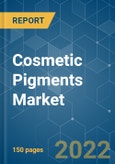The market for cosmetic pigment is expected to register a CAGR of over 6.25% during the forecast period (2022-2027).
The COVID-19 pandemic had a negligible impact on the market. However, the market has been estimated to grow steadily during the forecast period.
The global cosmetic pigments market is consolidated, with players accounting for a marginal share in the market. Some of the major companies (in no particular order) include DIC CORPORATION, Atlanta, Merck KGaA, Venator Materials PLC, and Fujian Kuncai Material Technology Co. Ltd.
This product will be delivered within 2 business days.
The COVID-19 pandemic had a negligible impact on the market. However, the market has been estimated to grow steadily during the forecast period.
Key Highlights
- The major factors driving the market studied are the increasing demand for cosmetics products in the Asia-Pacific region and the rapidly growing demand for organic pigments.
- On the flip side, new medical technologies for beauty enhancement are expected to hinder the growth of the market.
- The organic pigments segment is estimated to be the fastest-growing composition type in the cosmetic pigments market over the forecast period.
- The Asia-Pacific region represents the largest market and is also expected to be the fastest-growing market over the forecast period owing to the increasing consumption from countries such as China, India, Japan, and South Korea.
Key Market Trends
Inorganic Pigment Segment to Continue its Dominance
- Inorganic pigments are chemical compounds not based on carbon and are usually metallic salts precipitated from solutions.
- These pigments can be defined as insoluble compounds with a basis of metallic ions. Inorganic pigments are generally very resistant to the effects of light because the energy required to generate a breakdown of bonds is greater than that provided by sunlight.
- Most inorganic pigments are manufactured at high temperatures and are generally not affected by the process temperatures, making them resistant to heat.
- Inorganic colors (pigments) are composed of insoluble metallic compounds derived from natural sources (e.g., china clay, carbon deposits) or are synthesized. Inorganic pigments consist of iron oxides, chromium oxides, ultramarines, manganese violet, white pigments, and pearlescent effects.
- The high stability of inorganic pigment color and high particle dispersion make it a popular choice in the manufacture of cosmetics products. The dispersion benefits of inorganic pigment are expected to increase the industry’s growth rate and the development of the worldwide inorganic pigment market in the coming years.
- Therefore, due to the above-mentioned factors, the inorganic pigments segment is likely to dominate the cosmetic pigments market during the forecast period.
Asia-Pacific Region to Dominate the Market
- Currently, the Asia-Pacific region dominates the global market for the cosmetic pigments market. China and Japan are the leading consumers of cosmetic pigments in the region.
- The increasing cosmetic production capacities and consumption in countries such as China, India, and ASEAN countries, are expected to increase the demand for cosmetic pigments in the region.
- The estimated revenue of face products in China was USD 2,842.4 million in 2020. It is projected to reach USD 4,986.3 million in 2025. Also, the estimated revenue of lip products in the country was USD 3,121.5 million in 2020, and it is expected to be USD 5,011.4 million in 2025.
- The estimated revenue of face products in India was USD 1,312.9 million in 2020, and it is projected to reach USD 2,037.2 million in 2025. Also, the estimated revenue of lip products in the country was USD 1,282.3 million in 2020, and it is likely to reach USD 1,825.9 million in 2025.
- All these factors are expected to make the Asia-Pacific region dominate the global market.
Competitive Landscape
The global cosmetic pigments market is consolidated, with players accounting for a marginal share in the market. Some of the major companies (in no particular order) include DIC CORPORATION, Atlanta, Merck KGaA, Venator Materials PLC, and Fujian Kuncai Material Technology Co. Ltd.
Additional Benefits:
- The market estimate (ME) sheet in Excel format
- 3 months of analyst support
This product will be delivered within 2 business days.
Table of Contents
1 INTRODUCTION
4 MARKET DYNAMICS
5 MARKET SEGMENTATION
6 COMPETITIVE LANDSCAPE
Companies Mentioned (Partial List)
A selection of companies mentioned in this report includes, but is not limited to:
- Croda International Plc
- DIC CORPORATION
- ECKART
- GEOTECH
- IFC Solutions
- Kobo
- Koel Colours Pvt. Ltd
- LANXESS
- Merck KGaA
- Neelikon
- Ocres de France
- Sandream Impact LLC
- Sensient Cosmetic Technologies
- Sudarshan Chemical Industries Limited
- Sun Chemical
Methodology

LOADING...








